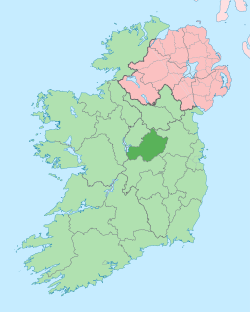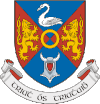Co Westmeath
|
Westmeath Contae na hIarmhí
|
||
|---|---|---|
|
||
| Nickname(s): 'The Lake County' | ||
| Motto(s): Triath ós Triathaibh (Irish) "Noble above nobility" |
||
 |
||
| Country | Ireland | |
| Province | Leinster | |
| Dáil Éireann | Longford–Westmeath and Meath-West (North Westmeath) | |
| EU Parliament | Midlands–North-West | |
| County town |
|
|
| Government | ||
| • Type | County Council | |
| Area | ||
| • Total | 1,840 km2 (710 sq mi) | |
| Area rank | 21st | |
| Population (2016) | 88,770 | |
| • Rank | 22nd | |
| Vehicle index mark code |
WH | |
| Website | www |
|
County Westmeath (/wɛstˈmiːð/ west-MEEDH; Irish: Contae na hIarmhí or simply An Iarmhí) is a county in Ireland. It is in the province of Leinster and is part of the Midlands Region. It originally formed part of the historic Kingdom of Meath (Midhe 'middle'). It was named Mide because the kingdom was located in the geographical centre of Ireland (the word Mide meant 'middle').Westmeath County Council is the administrative body for the county, and the county town is Mullingar. The population of the county is 88,770.
Following the Norman invasion of Ireland, the territory of the Gaelic Kingdom of Meath formed the basis for the Anglo-Norman Lordship of Meath granted by King Henry II of England to Hugh de Lacy in 1172. Following the failure of de Lacy's male heirs in 1241, the Lordship was split between two great-granddaughters. One moiety, a central eastern portion, was awarded to Maud (de Geneville) as the liberty of Trim; the other moiety, comprising north-eastern and western portions, went to Maud's sister Margery (de Verdun) and in 1297 became the royal county of Meath. The liberty and royal county were merged in 1461. While the east of the county was in the English Pale, the west was Gaelicised in the fourteenth century and outside the control of the sheriff of Meath.
...
Wikipedia

